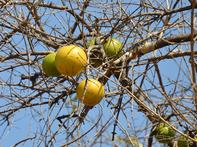Fruit is a delicious dietary staple in South Africa. The country is blessed with diverse soil that accommodates various indigenous trees that give fruits that has a variety of food and medicinal uses in various cultures.

According to the Department: Agriculture, Forestries and Fisheries (DAFF), these are considered the most important South African indigenous fruit crops: Marula, mobola plum, red milkwood fruit, wld medlar, kei apple, monkey orange, sour fig and sour plum.
Some indigenous fruits are an important item of trade and are sold along roadsides in many parts of southern Africa. These include monkey orange, sour figs (Carpobrotus edulis), umsobo (waterberry) in the eastern parts of South Africa, Kei-apple (Dovyalis caffra), sour plum (Ximenia caffra), blue sour plum (X. americana) and red milkwood (Mimusops species). Some show potential as new commercial crops and progress has been made with marula (Sclerocarya birrea).
Marula
This large fruit-bearing tree is commonly found in the Limpopo province of South Africa. The fruit is harvested as it falls off the tree (January to April) and eaten fresh or processed into a jam. It is also processed into alcoholic beverages such as beer and a popular liquor called Amarula.Mobola Plum
A large tree with a rough bark, the mobola plum grows in the eastern regions of South Africa. It produces little yellow fruit that's eaten raw, dried or fermented to a beer.Red Milkwood
This tree grows well the summer rainfall provinces of South Africa and produces small, round orange fruit. The sweet fruit is very high in vitamin C and the leaves are eaten by antelope. Harvested unripe, the fruit ripens in a few days.Wild Medlar
This fruit tree produces apricot-size fruit with a taste resembling that of dried apple. Fresh fruit is used to distil a very potent clear liquor called 'mampoer' in Afrikaans. The fruit must be hand-picked from the trees and can be harvested over a period of up to six months.Kei Apple
The tangy and aromatic Kei apple fruits are eaten raw, preferably sprinkled with sugar. The fruit is high in vitamin C and contains various amino acids. Its natural high acidity makes it good for jams. The thorny, bushy tree makes popular hedges.Monkey Orange
This small, thorny tree grows in tropical and subtropical regions in Africa, producing hard yellow fruit about the size of an orange. The flesh of the fruit is eaten raw, dried or made into jams or fruit wines. The seeds are poisonous.Sour Fig
The sour fig grows on a succulent creeper indigenous to the Western Cape. It makes good jams and is used for soil stabilisation and in water-wise gardens. Its leaf juice is used to soothe sunburns, scratches and itches.Sour Plum
This refreshingly sour fruit is found on a small thorny tree, often planted as a hedge. Eaten fresh, the fruit is high in vitamin C and its seed oil is used in cosmetics, such as lipsticks and soaps.By Marinda Louw